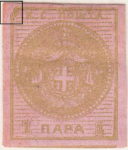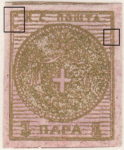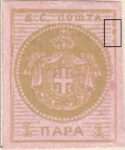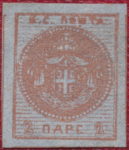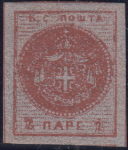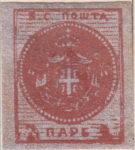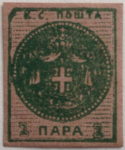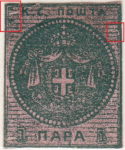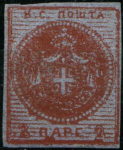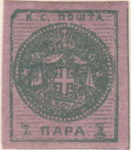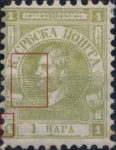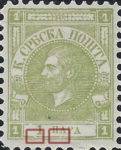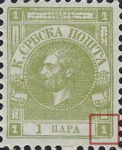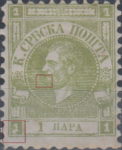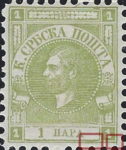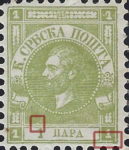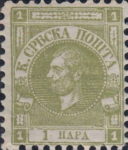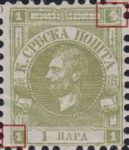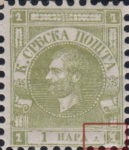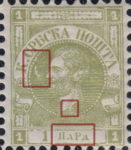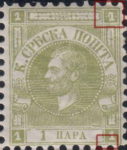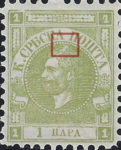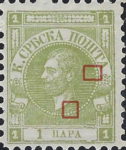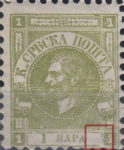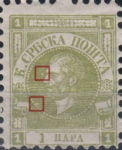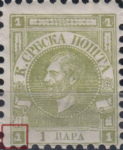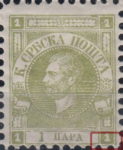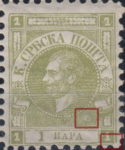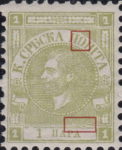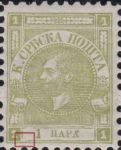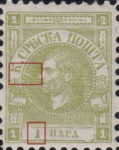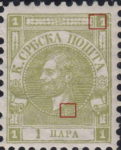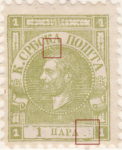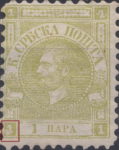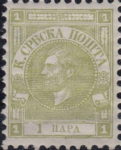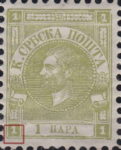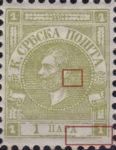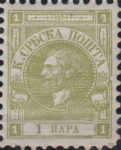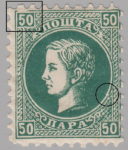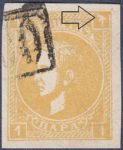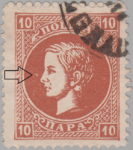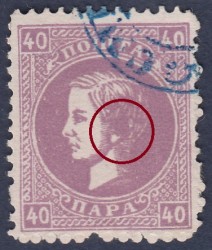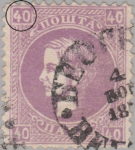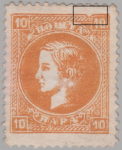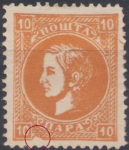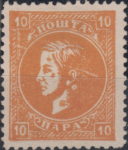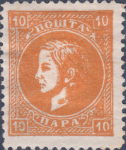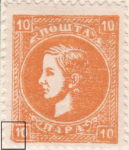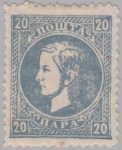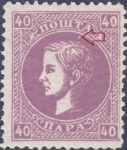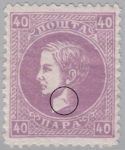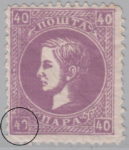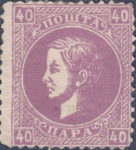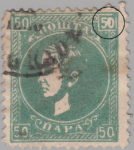The Principality of Serbia
Newspaper stamps of 1866
Designed by Mr. Anastas Jovanović, printed by State Printing Works in letterpress. Imperforate. Sheets consisted of 12 stamps (4×3). Every stamp in a sheet has unique characteristics (flaws) that enable collectors to easily reconstruct entire sheets.
| CHARACTERISTICS BY FIELDS | ||
|---|---|---|
| Field No. | 1 para | 2 pare |
| 1 |
|
|
| 2 |
|
|
| 3 |
|
|
| 4 |
|
|
| 5 |
|
|
| 6 |
|
|
| 7 |
|
|
| 8 |
|
|
| 9 |
|
|
| 10 |
|
|
| 11 |
|
|
| 12 |
|
|
1868/69. Newspaper stamps.
Between 1868 and 1869 there were at least two issues of newspaper stamps with effigy of Prince Mihajlo (Michael) III Obrenović. The first issue was released on 11 March 1867, stamps were perforated and printed in sheets of 50 (10×5). The second issue was released in November 1868, this time stamps were imperforate and printed in sheets of 100, with or without a gutter between the blocks of 50 stamps. The third issue is disputed as no official documentation on it exists, but due to significant differences in colors, papers and gum the stamps are classified as a separate issue.
| ISSUES | |||||||
|---|---|---|---|---|---|---|---|
| Value | Color | Issue | Run | Perforation | Paper | Gum | |
| 1 para | yellow-green to olive-green | 1st | 60.600 | line 9½ | ordinary, pelure is rare | colorless or yellowish, with bubbles | clean and clear |
| 2 pare | yellow-brown to olive-brown | 1st | 59.050 | line 9½ | ordinary, pelure is rare | colorless or yellowish, with bubbles | clean and clear |
| 1 para | green to dark green | 2nd | 26.900 | imperforate | ordinary | colorless, with bubbles | |
| 2 pare | reddish brown | 2nd | 23.800 | imperforate | ordinary | colorless, with bubbles | |
| 1 para | pale brown-olive-green to dark brown-olive-green | 3rd | ? | imperforate | thin, hard, brittle | colorless without bubbles | blurred |
| 2 pare | yellowish-brown | 3rd | ? | imperforate | thin, hard, brittle | colorless without bubbles | blurred |
In all printings the same cliches were used as the same plate errors as in the first printing occur in the second printing as well. In the second printing only the sequence of individual horizontal rows was changed.
The Prince Milan IV Obrenović Issues (1869-1880)
Before formation of the Universal Postal Union postal conventions were signed between individual states. New postal treaty between Serbia and Austria-Hungary and also the change of ruler in Serbia after the death of Prince Mihajlo III Obrenović made it necessary to print new stamps.
The new postal treaty required denominations of 15, 25, 35 and 50 para. Stamps were printed in letterpress in Belgrade State Printers (Državna štamparija).
This issue was in use for 11 years. During this period stamps were repeatedly reprinted on various kinds of paper, colors and shades. The great Serbian philatelist Eugen Derocco grouped 10 printings into 5 groups based on appearance of stamps. His classification is still valid today and used in most world stamp catalogs.
Characteristics of print groups
| DIFFERENTIATING BETWEEN PRINT GROUPS | |
|---|---|
|
General characteristics of Group A printings:
|
|
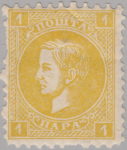 |
1 para (stamp for newspapers)
First printing (28 October 1869): 170.000 stamps. |
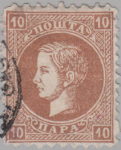 |
10 para The first printing:
The second printing:
First printing (28 October 1869): 99.000 stamps. |
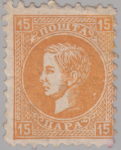 |
15 para
First printing (28 October 1869): 214.000 stamps. |
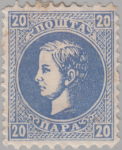 |
20 para (for ordinary letters weighing up to 3 drams)
First printing (28 October 1869): 766.500 stamps. |
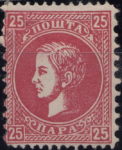 |
25 para
First printing (28 October 1869): 196.300 stamps. |
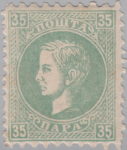 |
35 para
First printing (28 October 1869): 406.600 stamps. |
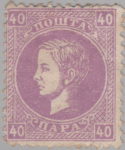 |
40 para
First printing (28 October 1869): 434.000 stamps. |
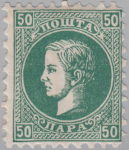 |
50 para
First printing (28 October 1869): 206.900 stamps. |
|
General characteristics of Group B printings
|
|
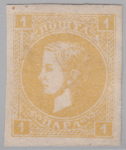 |
1 para (stamp for newspapers)
Third printing (6 May 1872): N/A. |
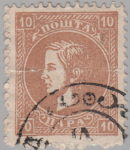 |
10 para
Third printing (6 May 1872): N/A. |
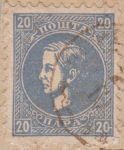 |
20 para
Third printing (6 May 1872): N/A. |
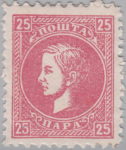 |
25 para
Third printing (6 May 1872): N/A. |
|
General characteristics of Group C printings This printing group used the same blocks as the printing group B.
|
|
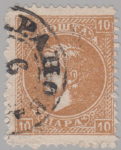 |
10 para
Fifth printing (4 June 1874): 97.400 stamps. |
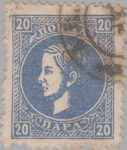 |
20 para
Fifth printing (4 June 1874): 200.000 stamps. |
|
General characteristics of Group D printings
|
|
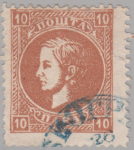 |
10 para
Seventh printing (22 April 1876): 290.000 stamps. |
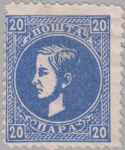 |
20 para
Seventh printing (22 April 1876): 420.000 stamps. |
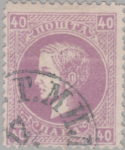 |
40 para
Seventh printing (22 April 1876): 215.000 stamps. |
|
General characteristics of Group E printings
|
|
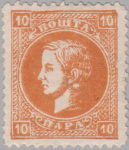 |
10 para
Tenth printing (8 February 1879): N/A. |
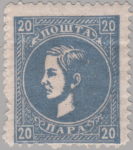 |
20 para
Tenth printing (8 February 1879): N/A. |
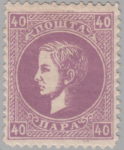 |
40 para The stamps were printed from the same plate as the previous printings of 40 para stamp (Groups A and D)
Tenth printing (8 February 1879): N/A. |
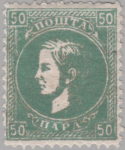 |
50 para
Tenth printing (8 February 1879): N/A. |
Constant varieties
| CONSTANT VARIETIES | |||
|---|---|---|---|
| Group B: 1 para | |||
| I | 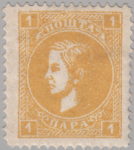 |
Most of the 1 para stamps of printing Group B are imperforate. The other stamps have sharply pointed perforation 12, looking different than other Prince Milan stamps. Their origin is not certain. | |
| Field №: ? | Pane: N/A | ||
| Other nomenclatures: – | |||
| Notes: part perforated examples. | |||
| Value €: – | |||
| Group B: 10 para | |||
| I | 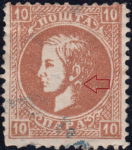 |
Circular scratch below Prince’s ear. The printing was done from new plates and new cliches, this flaw appears on all stamps in this and the four printings that followed. |
|
| Field №: ? | Pane: N/A | ||
| Other nomenclatures: – | |||
| Notes: – | |||
| Value €: – | |||
| Group D: 20 para | |||
| I | 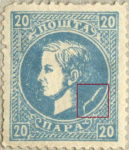 |
Crack inside medallion (“the bird”) in ex Yugoslavia also known as the snake (“zmija”). | |
| Field №: ? | Pane: N/A | ||
| Other nomenclatures: Rasic, p. 91 c | |||
| Notes: – | |||
| Value €: 35 | |||
| II | 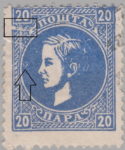 |
Crack in a plate below denomination box in the upper left corner. Note: circle in the medallion in front of Prince’s nose is not constant. |
|
| Field №: ? | Pane: N/A | ||
| Other nomenclatures: Rasic, p. 90 a | |||
| Notes: – | |||
| Value €: 25 | |||
| Group E: 20 para | |||
| I | 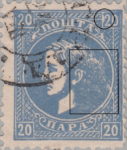 |
Big crack in the ornament to the right and damage spreading from the medallion to Prince’s hair. Numeral 2 in the upper right corner touching the frame. | |
| Field №: ? | Pane: N/A | ||
| Other nomenclatures: – | |||
| Notes: another example. | |||
| Value €: 20 | |||
| II | 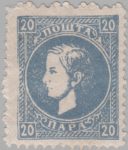 |
Prince’s effigy faded, left border damaged. | |
| Field №: ? | Pane: N/A | ||
| Other nomenclatures: – | |||
| Notes: another example. | |||
| Value €: 15 | |||
| Group E: 50 para | |||
| I | 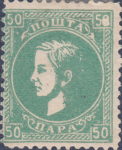 |
Zero of the top right denomination wider at bottom. | |
| Field №: ? | Pane: N/A | ||
| Other nomenclatures: – | |||
| Notes: another example. | |||
| Value €: 20 | |||
Possible constant varieties
Coincidental varieties
| COINCIDENTAL VARIETIES | ||
|---|---|---|
| GROUP E: 10 para | ||
| 1 | Shifted perforation. | 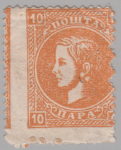 |
| 2 | Imperforate at the bottom, upper frame damaged. | 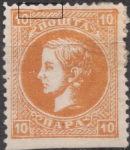 |
| GROUP E: 50 para | ||
| 1 | Overinking. | 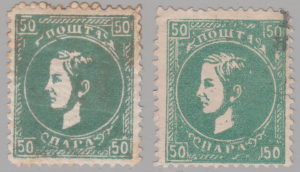 |
| 2 | Wide margins due to imprecise perforating. | 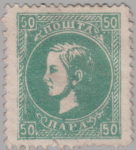 |
The Newspaper Stamps Issues of 1873 and 1878
Although they cannot be taken out of the context of other Prince Milan issues, the 2 para stamps are presented separately due to the change in the design. The first run (Type I) was issued on 1 June 1873 is placed in times of the fourth printing of Prince Milan stamps. The second run (Type II) is placed in times of the ninth printing (29 June – 29 December 1878).
The need for the 2 para newspaper stamp arose with the new law of 23 October 1871 which, starting from 1 January 1872, imposed postage of 2 para for newspapers that went through the mail. Until then, newspapers went free if sent domestically from publishers to subscribers without wrappers. The law of 19 December 1879 reintroduced free domestic mailing of newspapers, beginning 1 May 1880.
| TYPES | ||
|---|---|---|
| 2 para | ||
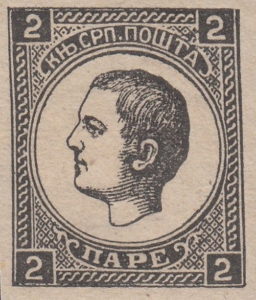 |
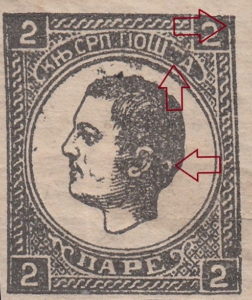 |
Type II:
The first printing in 1873 (Type I): 1.590.000 stamps. |
| Type I | Type II | |
| PANES | ||
| Type II, front Type II, back |
||
| COINCIDENTAL VARIETIES | ||
|---|---|---|
| 1 | Offset. | 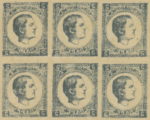 |
The issue of 1880-1890
This is the last issue of the Principality and at the same time the first issue of the Kingdom. The stamps were issued on 1 November 1880 and were in use until 3 March 1890, even though Serbia was proclaimed Kingdom on the 12 February 1882.
Adoption of the metric system in 1880 and changes in monetary system (from 40 para = 1 grosch to 100 para = 1 dinar) made a new issue of stamps necessary. Accordingly, postal rates were geared to the new metric system. The rate for 20 grams letter inland became 10 para and abroad 25 para. The old issues were demonetized.
Stamps were printed in letterpress by Belgrade State Printers (Državna štamparija), paper ordinary, perforation comb 13X13½. Sheet consisted of 100 stamps divided by horizontal and vertical gutters into panes of 25. Sheets had no margins.
There were several printings which can be distinguished by differences in gum, perforations, colors and transparency of print. All denominations can be found on two types of paper:
- 1880-1889: ordinary papers of medium thickness with differences in strength and quality.
- 1886-1889: grained paper of analogous thickness.
Types of gum:
- neutral, yellowish or brownish, applied thinly and regularly.
- neutral, yellowish, applied thinly, greasy appearance, so that the design of the stamp is clearly recognizable from the back.
- yellowish or brownish, applied thinly and irregularly, often with fine cracks.
| CONSTANT VARIETIES | Field number | ||
|---|---|---|---|
| I | 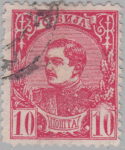 |
White spot above the right value, touching the upper parts of both figures. | |
| Field №: 73 | Pane: N/A | ||
| Other nomenclatures: – | |||
| Notes: – | |||
| Value €: 15 | |||
| POSSIBLE CONSTANT VARIETIES (not mentioned in literature) | ||
|---|---|---|
| 1 | Heavily shaded area at the back of the head. | 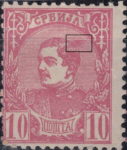 |
References
Bibliography
- Kardosh, Dr. Velizar M., The Principality of Serbia: postal History and Postage Stamps (1830-1882). ISBN 3-9521083-1-6.
- Katalog poštanskih maraka jugoslovenskih zemalja (1991), Jugomarka (Belgrade). YU ISSN 0351-4447
- Rasic R., Mirko (1979): The Postal History and Postage Stamps of Serbia. The Collectors Club Handbook No. 25, published by The Theodore E. Steinway Memorial Publication Fund. ISBN 0-912574-25-9.
Contributors
Some of the images on this page were contributed by:
- Mr. Predrag Simić, link

